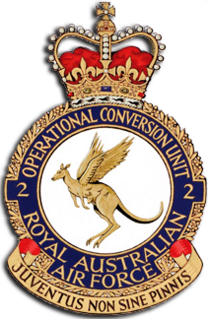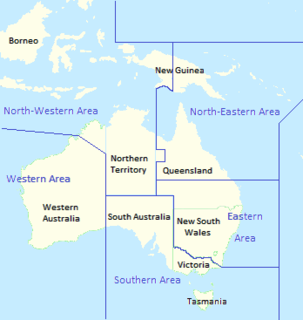
The Royal Australian Air Force (RAAF), formed in March 1921, is the aerial warfare branch of the Australian Defence Force (ADF). It operates the majority of the ADF's fixed wing aircraft, although both the Australian Army and Royal Australian Navy also operate aircraft in various roles. It directly continues the traditions of the Australian Flying Corps (AFC), formed on 22 October 1912. The RAAF provides support across a spectrum of operations such as air superiority, precision strikes, intelligence, surveillance and reconnaissance, air mobility, space surveillance, and humanitarian support.
The Airfield Defence Guard (ADG) mustering of the Royal Australian Air Force (RAAF) performs specialist ground defence tasks to protect air power assets from hostile ground action. The mustering is composed of non-commissioned members, commonly called 'ADGies,' most of whom are employed within a Security Forces (SECFOR) Squadron (SQN). Their primary role is the protection of RAAF equipment, personnel, assets and facilities during operations. While ADGs train to counter special forces as the primary ground threat to the projection of air power, ADGs are themselves conventional forces. Other duties include training RAAF personnel in weapon handling and basic ground defence tactics.

RAAF Base Richmond is a Royal Australian Air Force (RAAF) military air base located within the City of Hawkesbury, approximately 50 kilometres (31 mi) North-West of the Sydney Central Business District in New South Wales, Australia. Situated between the towns of Windsor and Richmond, the base is the oldest base in New South Wales and the second oldest in Australia. The base is home to the transport headquarters RAAF Air Lift Group, and its major operational formations, Nos. 84 and 86 Wings. The main aircraft type operated at the base is the Lockheed C-130 Hercules. Richmond is a regular venue for air shows and has at times been mooted as a site for Sydney's proposed second international airport.

Survival, Evasion, Resistance, and Escape (SERE) is a program best known by its military acronym that provides U.S. military personnel, U.S. Department of Defense civilians, and private military contractors with training in evading capture, survival skills, and the military code of conduct. Established by the U.S. Air Force at the end of World War II, it was extended and consolidated during the Vietnam War (1959–1975) to the U.S. Marine Corps, and U.S. Navy and in the late 1980s to the U.S. Army. Most higher level SERE students are military aircrew and special operations personnel considered to be at high risk of capture.

RAAF Base Pearce is the main Royal Australian Air Force (RAAF) military air base in Western Australia. The base is located in Bullsbrook, north of Perth. It is used for training by the RAAF and the Republic of Singapore Air Force.

No. 2 Operational Conversion Unit is a fighter training unit of the Royal Australian Air Force (RAAF). Located at RAAF Base Williamtown, New South Wales, the unit trains pilots to operate the McDonnell Douglas F/A-18 Hornet, conducts refresher courses for pilots returning to the type, and trains future Hornet instructors. Pilots new to the Hornet enter No. 2 OCU after first qualifying to fly fast jets at No. 79 Squadron and undertaking initial fighter combat instruction at No. 76 Squadron. Once qualified on the F/A-18, they are posted to one of No. 81 Wing's operational Hornet units, No. 3 Squadron, No. 75 Squadron or No. 77 Squadron.

No. 4 Squadron is a Royal Australian Air Force squadron composed of the air force special forces Combat Controllers, aircrew who operate the Pilatus PC-9A(F) aircraft and instructors for the Australian Defence Force Joint Terminal Attack Controller (JTAC) course.

No. 38 Squadron was a Royal Australian Air Force (RAAF) transport and training unit active between 1943 and 2018. It was formed on 15 September 1943 and saw service during World War II transporting supplies and personnel between Australia and the combat zones in New Guinea and Borneo, using Douglas Dakota aircraft. Following the war, the squadron conducted regular courier flights between Australia and Japan in 1947 and 1948. No. 38 Squadron was deployed to Singapore from 1950 to 1952, supplying Commonwealth forces engaged in the Malayan Emergency and undertaking courier flights across Asia. In 1954 it became responsible for training RAAF personnel to operate Dakotas.

RAAF Base Wagga is a Royal Australian Air Force (RAAF) military air base located 5.8 nautical miles southeast of the town of Wagga Wagga, in the suburb of Forest Hill, New South Wales, Australia.

No. 24 Squadron is a Royal Australian Air Force squadron. The squadron was formed in 1940 and saw action as a bomber squadron during World War II serving in the Pacific theatre against the Japanese, and undertaking operations during the Battle of Rabaul, and the New Guinea, New Britain and Borneo campaigns. The squadron was disbanded in 1946 following the conclusion of hostilities, but was re-formed in 1951. From then until 2010 the squadron was an RAAF Reserve squadron located near Adelaide, South Australia; for part of this time, until 1960, the squadron continued to perform flying duties, before converting to a ground support role. In 2010, the squadron combined with Combat Support Unit Edinburgh to become a Permanent Air Force unit and it currently forms part of No. 96 Wing, Combat Support Group.

Rattlesnake Island is one of the islands South of the Great Palm Island group, northwest of Magnetic Island and directly east of Rollingstone in the Halifax Bay, northern Queensland, Australia.

Air Force Training Group is the Royal Australian Air Force (RAAF) group responsible for training personnel. It is headquartered at RAAF Williams, Victoria. The group was established as Training Command in 1953. It formed part of Support Command between from 1959 to 1990, when it was re-established as Training Command. In July 2006, Training Command was re-formed as Air Force Training Group under Air Command. Air Force Training Group units are organised into Air Training Wing, Ground Training Wing, Reserve Training Wing, and RAAF College.

No. 84 Wing is a Royal Australian Air Force (RAAF) transport wing. Coming under the control of Air Mobility Group (AMG), it is headquartered at RAAF Base Richmond, New South Wales. The wing comprises No. 35 Squadron, operating Aliena C-27J Spartan transport Aircraft; No. 37 Squadron, operating Lockheed Martin C-130J Super Hercules medium transports; and a technical training unit, No. 285 Squadron.

North-Eastern Area Command was one of several geographically based commands raised by the Royal Australian Air Force (RAAF) during World War II. For most of its existence it controlled units based in central and northern Queensland as well as Papua New Guinea. It was formed in January 1942 from the eastern part of the former Northern Area Command, which had covered all of northern Australia and Papua. Headquartered at Townsville, Queensland, North-Eastern Area Command's responsibilities included air defence, aerial reconnaissance and protection of the sea lanes within its territory. Its flying units, equipped with fighters, reconnaissance bombers, dive bombers and transports, took part in the battles of Rabaul, Port Moresby and Milne Bay in 1942, and the landings at Hollandia and Aitape in 1944.
No. 27 Squadron RAAF is a Royal Australian Air Force (RAAF) reserve and ground support squadron located at RAAF Base Townsville, Queensland. The squadron was formed on 1 July 1981 to recruit and train RAAF reservists in the Townsville area and in July 2010 took on the additional role of providing support services to RAAF Base Townsville.

The 336th Training Group is a United States Air Force group with the mission to provide Air Force survival training. The group is located at Fairchild Air Force Base, Washington, with one subordinate unit at Naval Air Station Pensacola, Florida, and one at Eielson Air Force Base, Alaska.

The Defence Survive, Evade, Resist, Extract (SERE) Training Organisation, otherwise known as DSTO, is a military training organisation based at RAF St. Mawgan, Cornwall In the United Kingdom. DSTO is a tri-service organisation and trains personnel of the British armed forces in survival techniques, evading capture and resistance from interrogation, prior to overseas deployment.

William Lloyd Brill, & Bar was a senior officer and bomber pilot in the Royal Australian Air Force (RAAF). Born in the Riverina district of New South Wales, he was a farmer and a member of the Militia before joining the RAAF in 1940. After training in Australia and Canada, he was posted to Britain in 1941 to take part in the air war over Europe. Brill first saw combat with No. 460 Squadron RAAF, flying Vickers Wellington medium bombers. He was awarded the Distinguished Flying Cross (DFC) in May 1942 for attacking a target after his plane was badly damaged by anti-aircraft fire. Following assignment as an instructor with the Royal Air Force (RAF), he returned to the bombing campaign in January 1944 as a flight commander with No. 463 Squadron RAAF, flying Avro Lancaster heavy bombers.

Air Training Wing is the Royal Australian Air Force (RAAF) unit responsible for providing basic training for the force's pilots and aircrew, and training instructors. It also oversees the RAAF Museum.
No. 88 Squadron is a Royal Australian Air Force (RAAF) training unit. It is responsible for developing air combat tactics and training the RAAF's air warfare instructors, and forms part of the force's Tactics and Training Directorate.

















